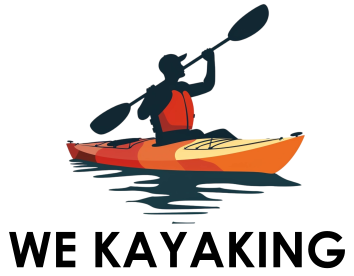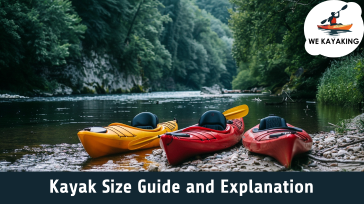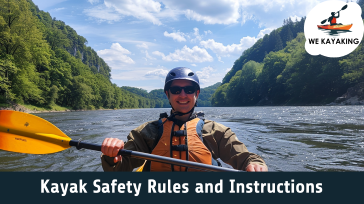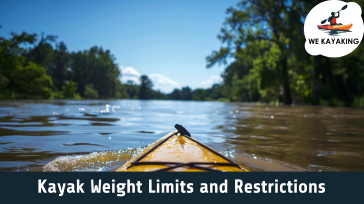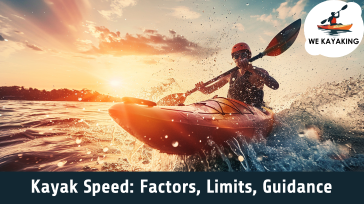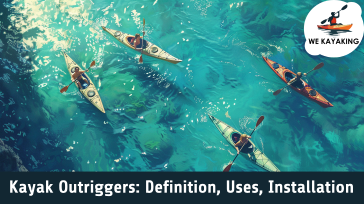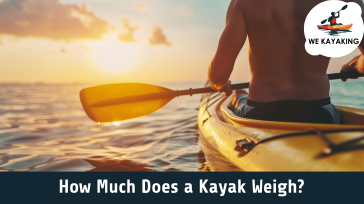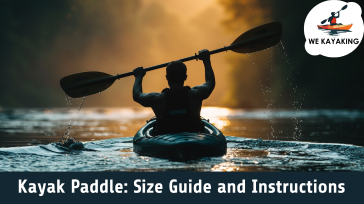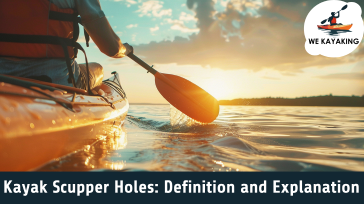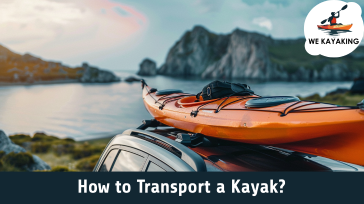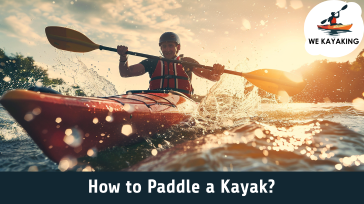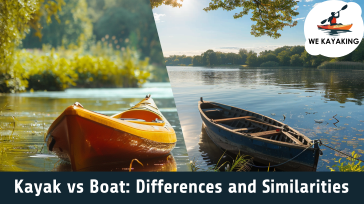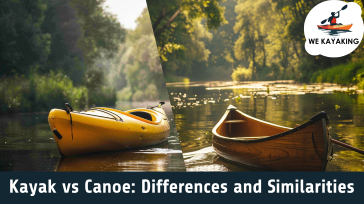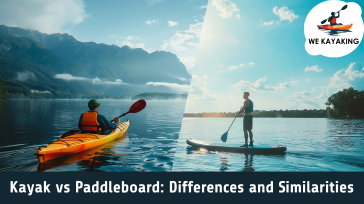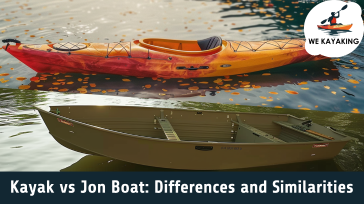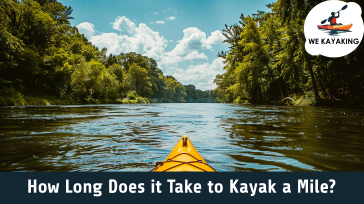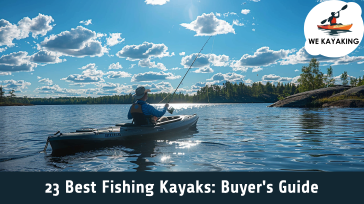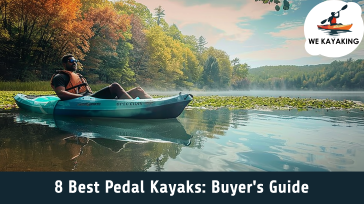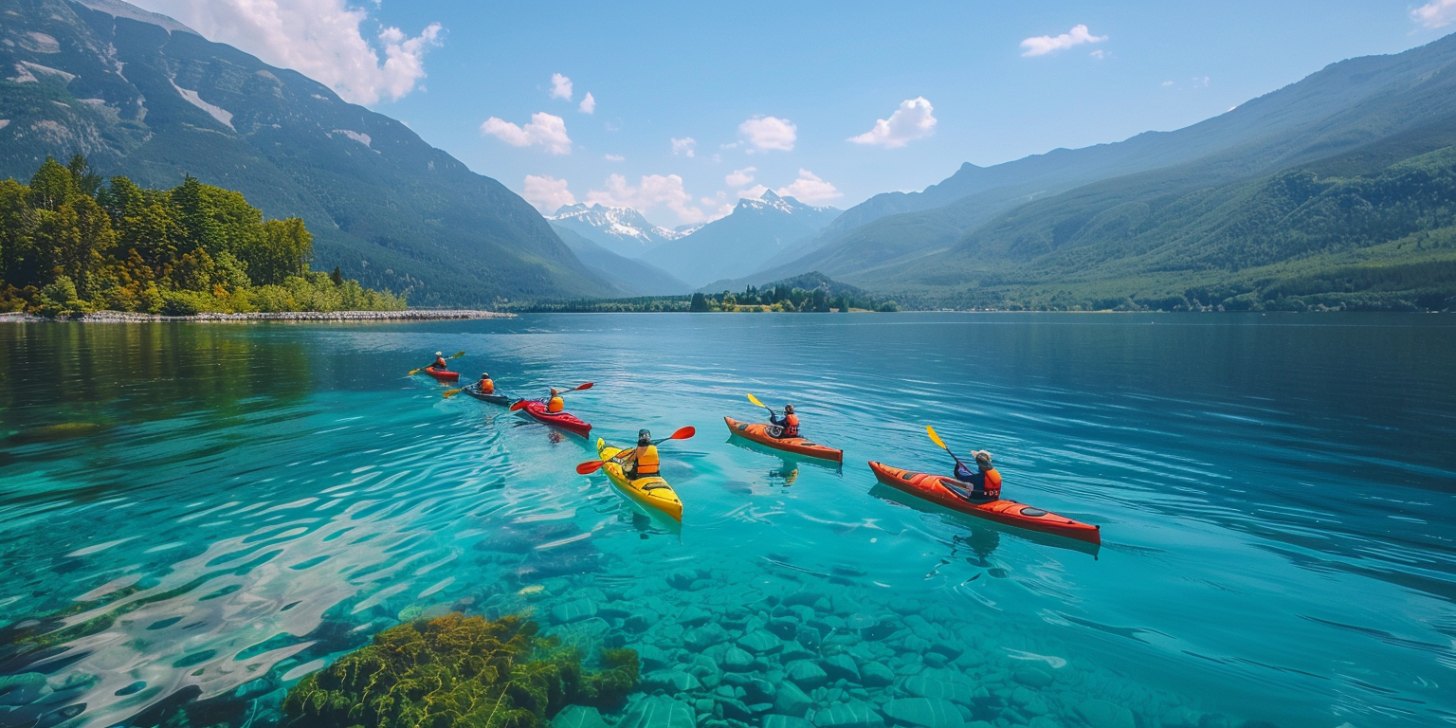
Everything About Kayaks: Instructions, Tutorials, Buying Guides
A kayak is a small, narrow boat propelled using a double-bladed paddle or in some cases, a pedal, often used in outdoor recreation and sports activities. When learning about kayaks, one discovers various types designed for specific purposes, ranging from serene lake paddling to the adrenaline rush of whitewater kayaking. The size of a kayak greatly influences its maneuverability and speed; longer kayaks tend to be faster and track better, while shorter ones are more agile. When choosing a kayak, safety is paramount; selecting the right size and type ensures a stable and secure experience on the water. Speed is another key consideration, varying by kayak design; touring kayaks, for instance, are built for speed and long-distance paddling.
A kayak’s weight affects its portability and handling, with lighter materials like fiberglass and carbon fiber offering ease of transport but at a higher cost. The materials used in kayak construction, including plastic, fiberglass, and inflatable options, also dictate durability and performance. Kayak shapes and hull designs contribute to stability, with wider kayaks providing more stability, which is crucial for beginners. Understanding these aspects helps individuals choose the right kayak for their needs, ensuring an enjoyable experience in outdoor recreation and sport.
What is a kayak?
A kayak is a small, narrow watercraft propelled by a double-bladed paddle. Modern kayaks vary widely in design and materials, catering to different paddling environments and purposes, such as recreational kayaking on calm waters, touring over long distances, whitewater kayaking through rapids, and fishing.
Key features of kayaks include their closed decks, with one or more cockpits for paddlers. Some kayaks are sit-on-top models, offering more freedom of movement and ease of entry. The length, width, and hull shape of a kayak influence its speed, stability, and maneuverability, with longer kayaks being faster but less agile.
Kayaks are made from materials such as rotomolded plastic, fiberglass, and inflatable fabrics, each offering a balance between durability, weight, and cost. This diversity in materials has facilitated kayaking’s growth from its functional roots into a widely enjoyed sport and form of outdoor recreation. It appeals to enthusiasts seeking adventure, relaxation, and a unique way to explore waterways.
What types of kayaks exist?
Diving into the vibrant and diverse world of kayaking, one discovers a rich tapestry of designs, each tailored to the unique demands of water environments and paddler preferences. From the serene glide of a touring kayak on open waters to the adrenaline rush of navigating rapids in a whitewater kayak, the spectrum of kayaks caters to every whim and skill level. Here’s a closer look at the 15 types of kayaks, each with its own character and purpose;
- Touring kayak
- Recreational kayak
- Whitewater kayak
- Sit-inside kayak
- Sit-on-top kayak
- Tandem kayak
- Inflatable kayak
- Hardshell kayak
- Fishing kayak
- Surf kayak
- Pedal kayak
- SUP kayak hybrid
- Racing kayak
- Surfski
- Motorized kayaks
1. Touring kayak
The touring kayak, also known by the alternative name of sea kayak, stands out as a distinct type within the kayaking world, celebrated for its design that marries elegance with efficiency. Crafted for the open waters of seas and large lakes, this vessel is distinguished by its longer and narrower hull, a key feature that enhances its glide and stability over long distances, making it the ideal choice for extended paddling adventures.
Unlike its counterparts, the touring kayak has ample storage capacity, with sealed hatches that protect gear and provisions from the elements, ensuring paddlers are well equipped for multi-day journeys. Its rudder or skeg system, another defining characteristic, aids in navigation and control, especially in challenging conditions such as strong currents or winds. The touring kayak’s sophisticated design, focusing on speed, distance, and cargo capacity, sets it apart. It offers a blend of performance and utility that appeals to the adventurous soul seeking to explore vast waterways.
2. Recreational kayak
The recreational kayak, simply referred to as a “rec kayak” in paddling communities, is a type celebrated for its user-friendly design, making it a favorite among casual paddlers and beginners. This kayak is characterized by its wide hull, a crucial element that provides exceptional stability and ease of use, instilling confidence in paddlers of all skill levels.
The recreational kayak features a larger cockpit, offering easy entry and exit, which is particularly appealing for those new to the sport or those who prefer a less confined paddling experience. Its shorter length, another defining attribute, enhances maneuverability, allowing for effortless navigation through calm waters like quiet lakes, slow-moving rivers, and coastal inlets. The emphasis on comfort is further evidenced by the generous seating space and sometimes adjustable footrests, catering to a relaxed paddling style. These key aspects, from its stability and spacious cockpit to its user-friendly maneuverability, distinguish the recreational kayak as the go-to choice for leisurely exploration and serene water adventures.
3. Whitewater kayak
A whitewater kayak, also known in specific circles as a “creek boat” or “playboat” depending on its design and use, is a type of kayak carefully engineered for the dynamic and unpredictable conditions of whitewater rivers and rapids. The hallmark of a whitewater kayak lies in its compact and robust build, which ensures agility and resilience in navigating through turbulent waters.
In contrast to those kayaks built for serene waters, this kayak boasts a shorter length and a pronounced rocker, the upward curve of the hull from bow to stern, which are key in enhancing its maneuverability and ability to ride over waves and avoid obstacles. Another distinctive feature is its low volume design, particularly in playboats, which enables paddlers to perform a variety of tricks and maneuvers, such as spins and flips. Whitewater kayaks are also equipped with adjustable outfitting inside the cockpit to secure the paddler, ensuring a snug fit that offers greater control and responsiveness to the kayak’s movements. These critical characteristics, from the pronounced rocker and compact size to the specialized outfitting, underscore the whitewater kayak’s unique suitability for the exhilarating and demanding realm of whitewater paddling.
4. Sit-inside kayak
A sit-inside kayak is a type of kayak characterized by its enclosed cockpit design, where the paddler sits inside the hull of the kayak. This traditional design is one of the key features distinguishing it from other types, offering enhanced protection from the elements, which is particularly beneficial in cooler water conditions or during inclement weather. The sit-inside kayak includes a spray skirt, and a waterproof cover that seals the cockpit, preventing water from waves or splashes from entering the kayak, thus keeping the paddler dry and warm.
Another unique aspect of this type of kayak is its lower center of gravity, which contributes to greater stability and efficient paddling. The sit-inside design also allows for more direct control of the kayak through body movements, offering an intimate connection with the water and enhanced maneuverability. These characteristics, the enclosed cockpit, spray skirt compatibility, and lower center of gravity, set the sit-inside kayak apart, making it a favored choice for those seeking a more traditional kayaking experience with added protection and control.
6. Tandem kayak
A tandem kayak, also known as a “double kayak,” is a type specifically designed to accommodate two paddlers, setting it apart from the solo experience offered by single kayaks. The defining characteristic of a tandem kayak is its dual seating arrangement, which fosters a collaborative paddling experience, making it an ideal choice for partners, friends, or families looking to share the adventure.
Unlike single kayaks, tandem kayaks are longer, a key feature that provides the necessary space for two paddlers and contributes to the kayak’s stability and speed in the water. This increased length, however, also means that tandem kayaks require coordinated effort and communication between paddlers for effective maneuvering and navigation. Another distinctive aspect is the increased storage capacity, allowing for more gear and supplies, which is particularly advantageous for longer trips or expeditions. These elements, the dual seating, longer length, and enhanced storage capacity, underscore the unique appeal of tandem kayaks for those seeking a shared paddling experience with the added benefits of stability and space.
7. Inflatable kayak
An inflatable kayak is a type of kayak distinguished by its air-filled construction, offering unparalleled portability and convenience. The core feature of an inflatable kayak is its air chambers, which not only provide buoyancy but also allow the kayak to be deflated and folded for easy transport and storage, a stark contrast to the rigid structure of hardshell kayaks. This adaptability makes inflatable kayaks especially appealing to those with limited storage space or the desire to travel with their kayak.
Another key aspect is the kayak’s material, a durable, puncture resistant fabric, which ensures resilience against abrasions and impacts, a common concern for inflatable watercraft. Despite misconceptions about their durability, modern inflatable kayaks boast robust designs capable of withstanding challenging conditions. The combination of these features, the air chambers, foldable design, and durable material, highlights the inflatable kayak’s unique blend of convenience, portability, and performance, making it a versatile choice for a wide range of paddling adventures.
8. Hardshell kayak
A hardshell kayak, also known as a rigid kayak, is a type characterized by its solid, one-piece construction, made from materials such as polyethylene, fiberglass, or composite blends. The defining feature of a hardshell kayak is its rigid hull, which provides superior durability and performance in a variety of water conditions, from calm lakes to challenging ocean waves.
The hardshell’s sturdy construction offers enhanced responsiveness and speed, allowing for more precise maneuvering and a smoother paddling experience. Another key aspect is the maintenance factor; hardshell kayaks are more resistant to wear and tear and require less upkeep compared to their
counterparts, aside from the occasional need for hull repair in the case of severe impact. The combination of these elements, the rigid hull, material variety, and low maintenance, sets the hardshell kayak apart as a favored option for enthusiasts seeking a high-performance, durable vessel for their aquatic adventures.
9. Fishing kayak
A fishing kayak is a type of kayak meticulously engineered with the angler in mind, referred to as an “angler kayak” in paddling circles. Its unique design incorporates several key features tailored to the needs of fishing enthusiasts. The stability of a fishing kayak is paramount. Its wide hull design ensures a steady platform for casting lines and reeling in catches, even in choppy waters. This type of kayak is also distinguished by its customization options. It includes built-in rod holders, gear tracks, and mounting points for accessories like fish finders and GPS systems, which are not found on standard kayaks.
Ample storage is another hallmark, with dedicated spaces for tackle boxes, coolers, and live wells, ensuring that all necessary equipment is within reach. Moreover, many fishing kayaks are equipped with comfortable, adjustable seating that allows for longer periods on the water without discomfort. These characteristics, the enhanced stability, customization options, ample storage, and comfortable seating, define the fishing kayak, making it an indispensable tool for those who combine the passion for paddling with the art of angling.
10. Surf kayak
A surf kayak is a type specifically designed for the dynamic environment of ocean surf. This kayak stands out due to its unique hybrid design which blends elements of both kayaking and surfing. The key feature of a surf kayak is its planing hull, which is flat and wide, similar to a surfboard, allowing it to glide smoothly over waves and offering the agility needed for carving turns on the face of a wave.
Surf kayaks, unlike traditional kayaks, come equipped with fins or skegs under the hull, which improve tracking and stability when surfing down a wave, much like a surfboard. Another distinctive aspect is the tight-fitting cockpit, which secures the paddler and prevents water ingress, a crucial factor when navigating through breaking waves. The combination of these elements, the planing hull, fins, and tight cockpit, distinguishes the surf kayak as an exhilarating fusion of kayaking and surfing, providing a unique paddling experience on the ocean’s waves.
11. Pedal kayak
A pedal kayak is a type distinguished by its innovative propulsion system, which allows paddlers to navigate waters using leg power. The hallmark of a pedal kayak is its pedal drive system, a key feature that sets it apart from traditional paddle kayaks. This mechanism involves either push pedals or a rotational pedal system, similar to that of a bicycle, which drives a propeller or flippers beneath the kayak, providing movement. The advantage of this system is the ability to keep hands free, enabling activities such as fishing, photography, or bird watching while on the move.
Another distinct aspect of pedal kayaks is their wider hull design, which offers increased stability to accommodate the pedal drive system and the activities it enables. Moreover, many pedal kayaks come equipped with rudder systems, controlled by hand levers, to aid in steering, further enhancing their maneuverability. These features, the pedal drive system, wider hull, and rudder steering, make the pedal kayak a versatile and efficient choice for those seeking a hands-free paddling experience with the added benefit of a workout for the legs.
12. SUP kayak hybrid
A SUP kayak hybrid is a versatile type of kayak that merges the functionalities of a stand-up paddleboard (SUP) with those of a kayak. The defining feature of this hybrid is its adaptability, allowing users to transition between standing up and paddling, like on an SUP and sitting down to paddle like in a kayak. This flexibility is facilitated by a removable or convertible seat, which is added for seated kayaking or removed for stand-up paddling.
Another key aspect of the SUP kayak hybrid is its wider and longer board design, which provides the stability needed for both standing and seated paddling, catering to a broad range of activities from leisurely paddles to fishing. The inclusion of paddle holders and footrests in some models further enhances the kayak-like experience, offering comfort and efficiency. These features, the convertible seating, board design, paddle holders, and footrests, distinguish the SUP kayak hybrid as a multi-use platform, ideal for paddlers looking to enjoy the best of both worlds in water recreation.
13. Racing kayak
Racing kayaks are kayaks optimized for speed and agility. Distinct from their leisure or touring counterparts, these kayaks feature a slender, elongated hull that slices through water with minimal resistance, enabling rapid movement. Crafted from advanced, lightweight materials like carbon fiber, they offer an unparalleled blend of speed and durability.
The cockpit, snug and form-fitting, ensures a seamless transfer of the paddler’s energy into forward motion, while an intricate rudder system, maneuvered via foot pedals, provides precise control even at high velocities. This combination of a streamlined hull, cutting-edge materials, and precision control mechanisms sets racing kayaks apart, making them the vessels of choice for those seeking to conquer competitive watersports.
14. Surfski
Surfskis are specialized watercraft designed primarily for speed and ocean surfing. Unlike traditional kayaks, surfskis boast an open cockpit design, which facilitates quick re-entry from the water, a critical feature when navigating through the surf and rough ocean conditions. This unique aspect not only differentiates them from conventional kayaks but also enhances their appeal among adventure seeking paddlers and competitive racers alike.
Key distinguishing features of surfskis include their long, narrow hulls, which are engineered for minimal water resistance and exceptional speed over the water. The inclusion of a foot-operated rudder system is another standout aspect, offering precise control and maneuverability, particularly in challenging sea conditions. What’s more, the lightweight construction of surfskis, employing advanced composites like carbon fiber, contributes to their agility and performance capabilities.
15. Motorized kayaks
Motorized kayaks, often referred to as powered kayaks, bring a unique blend of traditional paddling and modern propulsion technology to the kayaking experience. These kayaks are distinguished by the integration of a motor, which enhances their versatility and range. These kayaks appeal particularly to anglers and explorers who need to cover larger distances. Key elements that set motorized kayaks apart include the motor system, which varies from electric to small gas engines, offering a propulsion boost. This addition allows for greater speed and less physical strain, beneficial in situations like fighting against currents or wind.
Another distinguishing feature is the battery compartment and control system in electric models, which are designed to be water-resistant and user-friendly, allowing for smooth operation while on the water. The inclusion of a motor also necessitates a reinforced hull design to accommodate the additional weight and ensure stability and durability, even with the motor’s vibrations and forces at play. Moreover, motorized kayaks come equipped with customizable mounting points and accessories, catering to the needs of fishing enthusiasts who want to install fish finders, rod holders, and other gear to enhance their fishing experience.
What sizes of kayaks exist?
Kayak sizes encompass a broad spectrum, from nimble, compact models that are just over 6 feet in length, ideal for playful maneuvering and tight waterways, to extensive, 14-foot or longer tandem kayaks designed for stability and pace on open waters. This variance in kayak sizes is pivotal during the selection process, as it aligns with distinct kayaking disciplines and user preferences. Shorter kayaks excel in swift, responsive movements, perfect for the twisting turns of river rapids or the intricate exploration of coastal inlets, where agility trumps speed. Their compact nature also makes them easier to transport and store, an appealing factor for casual paddlers with limited space.
Conversely, longer kayaks are the go-to for adventurers seeking the serenity of long-distance touring or the rhythmic challenge of sea kayaking. Their extended length not only cuts through water more efficiently, ensuring smoother, faster travel over vast stretches but also provides ample storage for gear, making them ideal for multi-day expeditions. Besides, the added length contributes to better tracking, keeping the kayak on a straighter path, a quality that novice kayakers find reassuring.
Are kayaks safe?
Kayaks are considered safe for various water activities when used appropriately and with proper safety measures in place. Bettany Carter from kayakaddicts.com emphasized “Just like any other outdoor sport, kayaking has a fair share of risks. Some risks are uncontrollable. After all, you aren’t able to change the weather or redirect currents and tides. But most are avoidable.” The safety of kayaking is enhanced by choosing the right type of kayak for the specific water conditions you plan to navigate, wearing appropriate safety gear like life vests, and having knowledge of the environmental conditions such as sun exposure, wind, tide, and potential hazards like underwater obstacles and wildlife.
Selecting a kayak that suits your intended activities and skill level is crucial. For instance, taking a touring kayak into rapid river conditions or using a playboat for long-distance touring could lead to difficulties due to the mismatch between the kayak’s design and the demands of the water environment. According to Carter, B. (2023), “Is kayaking dangerous? 18 risks and how to avoid them,” from kayakaddicts.com. Understanding and preparing for environmental factors like sun exposure, which leads to heat stroke or dehydration, and adverse weather conditions that change the dynamics of your kayaking experience are also key to ensuring safety.
Wearing a life vest at all times, being aware of air and water temperatures, checking wind and tide conditions, staying within sight of the shore, and having basic first aid knowledge greatly contribute to a safer kayaking experience. It’s also advisable to carry essential safety equipment, such as a bilge pump, whistle, first aid kit, navigation devices, and a helmet for certain conditions, to be prepared for any emergencies that arise.
What determines kayak speed?
The speed of a kayak is determined by a combination of factors that include kayak design, hull type, weight, material, environmental conditions, and the paddler’s skill and stamina. Each of these elements plays a crucial role in how fast a kayak travels through water, and understanding their impact significantly influences the decision-making process when choosing a kayak, especially if speed is a key consideration.
The dimensions of a kayak, particularly its length and width, are essential in determining its speed. Longer kayaks tend to glide through the water more smoothly and are faster than shorter ones due to reduced drag. Conversely, wider kayaks offer more stability but at the cost of increased resistance, which slows down the kayak.
The shape of the kayak’s hull also affects its speed. A planing hull, designed to lift and skim over the water, reaches high speeds but lacks stability. A Swede-form hull, characterized by a narrow bow and wider stern, minimizes water resistance at the front, facilitating better speed and tracking over distances. The weight of the kayak, including the paddler and any gear, influences speed. Lighter kayaks are easier to propel and achieve higher speeds easily, but it’s important to balance weight with durability and the kayak’s ability to withstand different conditions.
The construction materials of a kayak impact its speed. Lightweight materials like fiberglass and carbon fiber offer better speed performance due to their reduced weight and enhanced responsiveness, although they come with a higher price tag and less durability compared to heavier materials like plastic. Environmental Conditions: Factors such as wind, currents, and tides greatly affect kayak speed. Paddling with the wind or current boosts speed, while adverse conditions hinder progress and make paddling more challenging.
When choosing a kayak, it’s important to consider how these factors align with your kayaking goals and the conditions you anticipate encountering. For speed enthusiasts or those looking to cover long distances, a longer, narrower kayak constructed from lightweight materials is ideal. For more leisurely paddling or in conditions where stability is paramount, other design considerations take precedence. Balancing these factors according to your specific needs and preferences will help you select the most suitable kayak for your adventures.
How much does the kayak weigh?
The weight of a kayak varies depending on its type, materials, and features. On average, kayaks weigh between 20 to 80 pounds (9 to 36 kilograms), with some models even exceeding 100 pounds (46 kilograms). For instance, tandem kayaks, which are designed for two people, weigh between 50 to 80 pounds (23 to 36 kilograms) due to their larger size and capacity. Touring kayaks, known for their lighter construction, range from 25 to 35 pounds (11 to 16 kilograms), particularly those made from lightweight composite materials like fiberglass or carbon fiber.
Material plays a substantial role in a kayak’s weight. Plastic kayaks, made from materials like polyethylene, are usually the heaviest. In contrast, kayaks constructed from fiberglass, carbon fiber, or other composite materials tend to be lighter. For example, recreational kayaks built to withstand rougher conditions weigh around 40 pounds (18 kilograms) if made from tougher plastic.
The kayak’s weight is an important consideration for transportation and handling. Heavier kayaks offer more stability but are challenging to transport, especially if you need to lift them onto a car roof by yourself. Inflatable kayaks present a lighter alternative, with some models weighing as little as 17 pounds (8 kilograms), which makes them easy to carry and transport.
When choosing a kayak, consider how you’ll transport and store it, as well as the type of kayaking you plan to do. If ease of transport and handling is a priority, lighter kayaks or inflatable models are more suitable. However, if stability and durability in rougher waters are more important, a slightly heavier and more rugged kayak could be a better choice.
What materials is the kayak made of?
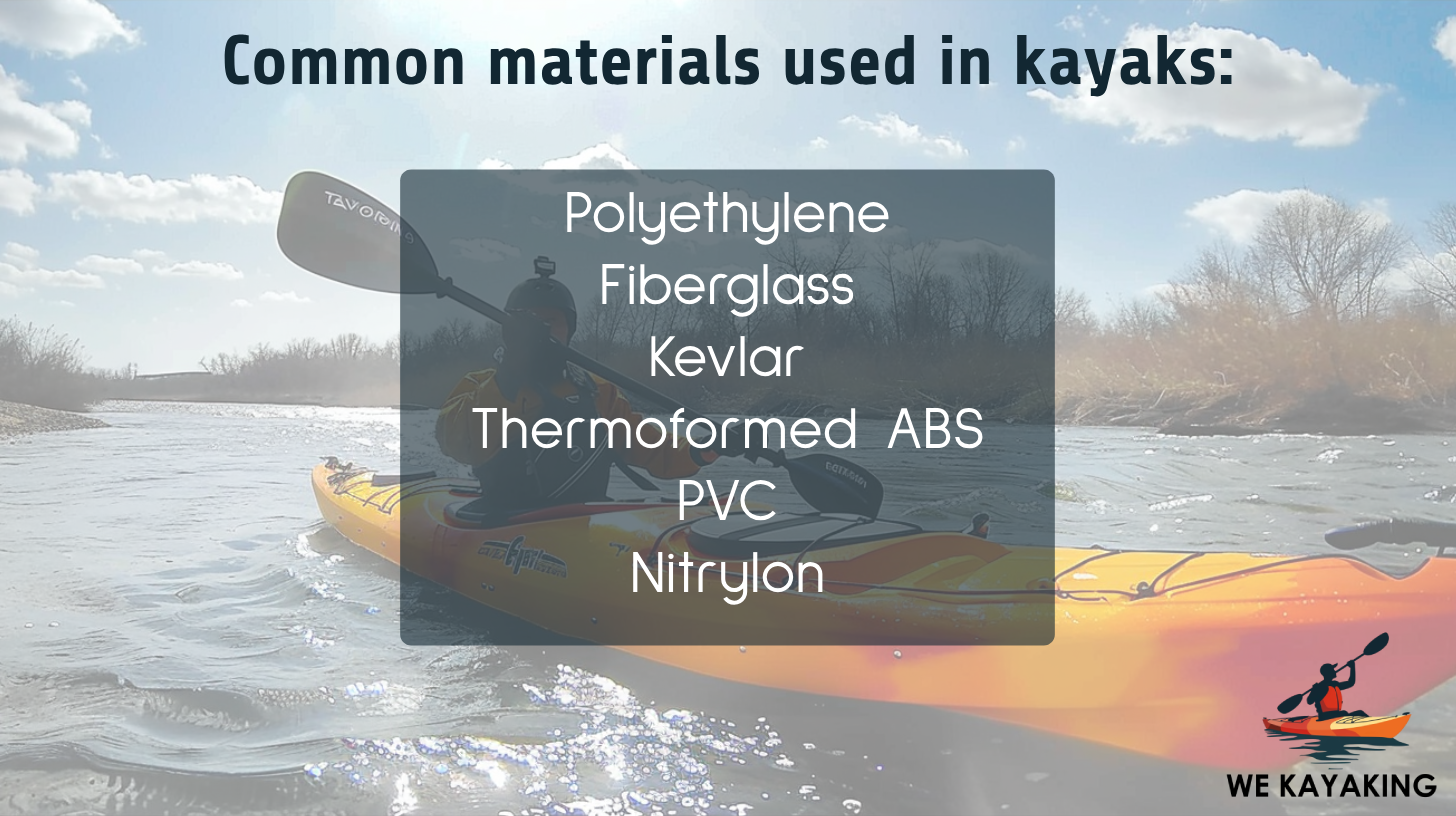 Kayaks are constructed from a variety of materials, each selected for their unique properties that impact the kayak’s performance, durability, weight, and cost. Polyethylene plastic is widely used due to its durability and affordability, making it a popular choice for recreational kayaks. These kayaks are known for their ability to withstand impacts and rough handling, ideal for challenging conditions. However, their heavier weight makes transportation and handling more cumbersome.
Kayaks are constructed from a variety of materials, each selected for their unique properties that impact the kayak’s performance, durability, weight, and cost. Polyethylene plastic is widely used due to its durability and affordability, making it a popular choice for recreational kayaks. These kayaks are known for their ability to withstand impacts and rough handling, ideal for challenging conditions. However, their heavier weight makes transportation and handling more cumbersome.
Composite materials, such as fiberglass, Kevlar, and carbon fiber, are favored for their lightweight and high-performance qualities. Kayaks made from these materials offer enhanced speed and maneuverability, appealing to more experienced paddlers or those seeking efficiency in their paddling experience. While composite kayaks excel in performance, they tend to be more susceptible to damage upon impact and are more expensive than their plastic counterparts.
Thermoformed ABS (acrylonitrile butadiene styrene) kayaks strike a balance between the durability of plastic and the lightweight, performance-oriented nature of composites. This material offers good resistance to UV damage and is easier to repair than some other materials, making it a practical choice for paddlers looking for a blend of performance and durability without the higher cost of composite kayaks.
Inflatable kayaks, made from materials like PVC and Nitrylon, stand out for their portability and ease of storage. While they offer the advantage of being lightweight and easy to transport, they are more susceptible to punctures and do not provide the same level of performance as hard-shell kayaks. Inflatable kayaks are best suited for calm waters and paddlers prioritizing convenience.
Choosing the right material depends on factors such as the type of kayaking you plan to do, your budget, storage and transportation options, and personal preferences. Each material has its trade-offs, and understanding these helps you select a kayak that best meets your needs and enhances your paddling experience.
What are the common shapes of kayaks?
The shape of a kayak’s hull is a major factor in determining its performance on the water. One common shape is the flat hull, known for its excellent primary stability, making it an ideal choice for beginners and recreational paddlers who prefer calm waters or are into activities like fishing. The wide and flat bottom of these kayaks offers a stable platform, although they are not the fastest on the water and are less responsive in rough conditions.
Another common shape is the rounded hull, which is excellent at providing secondary stability. Because of its ability to move through the water more efficiently, this shape is better suited for more experienced paddlers or those traveling through rougher conditions. It also makes maneuvering the kayak easier. Rounded hulls work incredibly well when in motion, especially in difficult conditions, but they feel less stable when stationary.
V-shaped hulls, or displacement hulls, are another design that features a pronounced keel line, which helps in cutting through the water more effectively, enhancing the kayak’s speed and tracking ability. These hulls are common in touring/sea kayaks and are designed for longer trips on open waters. The sharp V of the hull cuts through the water and aids in maintaining a straight path, but it requires more skill to balance compared to a flat hull.
When selecting a kayak, it is critical to comprehend these hull shapes and how they interact with the water. The balance of stability, speed, and maneuverability that each shape offers varies depending on the skill level of the paddler and the intended use of the kayak. Whether you’re a beginner looking for a stable platform for leisurely paddles or an experienced paddler seeking a kayak that handles the challenges of open water or rapid rivers, there’s a hull design that meets your needs.
What determines kayak stability?
Kayak stability is determined by a combination of factors, including hull shape, width, length, and volume, all of which play a major role in how a kayak performs. The hull shape is particularly influential, with flat hulls providing the best primary stability on calm waters, making them ideal for beginners and leisure paddlers. Rounded hulls, on the other hand, offer better secondary stability and are suitable for rougher waters where a kayak tilts or leans more. V-shaped hulls are designed for speed and efficient straight-line tracking but do not provide the level of stability desired by novice paddlers.
The width of a kayak also affects its stability, with wider kayaks offering more primary stability, making them feel more secure on flat water. However, this comes at the cost of speed and efficiency. Length plays a less direct role in stability but influences a kayak’s overall performance, with shorter kayaks being more maneuverable and potentially feeling more stable in certain conditions, while longer kayaks are better for tracking and speed over distance.
In addition to these physical characteristics, a paddler’s technique and comfort with the kayak also impact perceived stability. Primary stability is important for calm waters and activities like fishing where the kayak won’t be tilting much, whereas secondary stability becomes critical in rough waters, surf, or whitewater, where the kayak’s ability to recover from tilts is vital.
When choosing a kayak, consider where you’ll be paddling and your experience level. Beginners or those sticking to calm lakes and rivers prioritize primary stability, while more adventurous or experienced paddlers heading into the ocean or down whitewater rivers look for kayaks with better secondary stability. Testing different kayaks helps you find the right balance of stability and performance for your activities.
What is a kayak skeg?
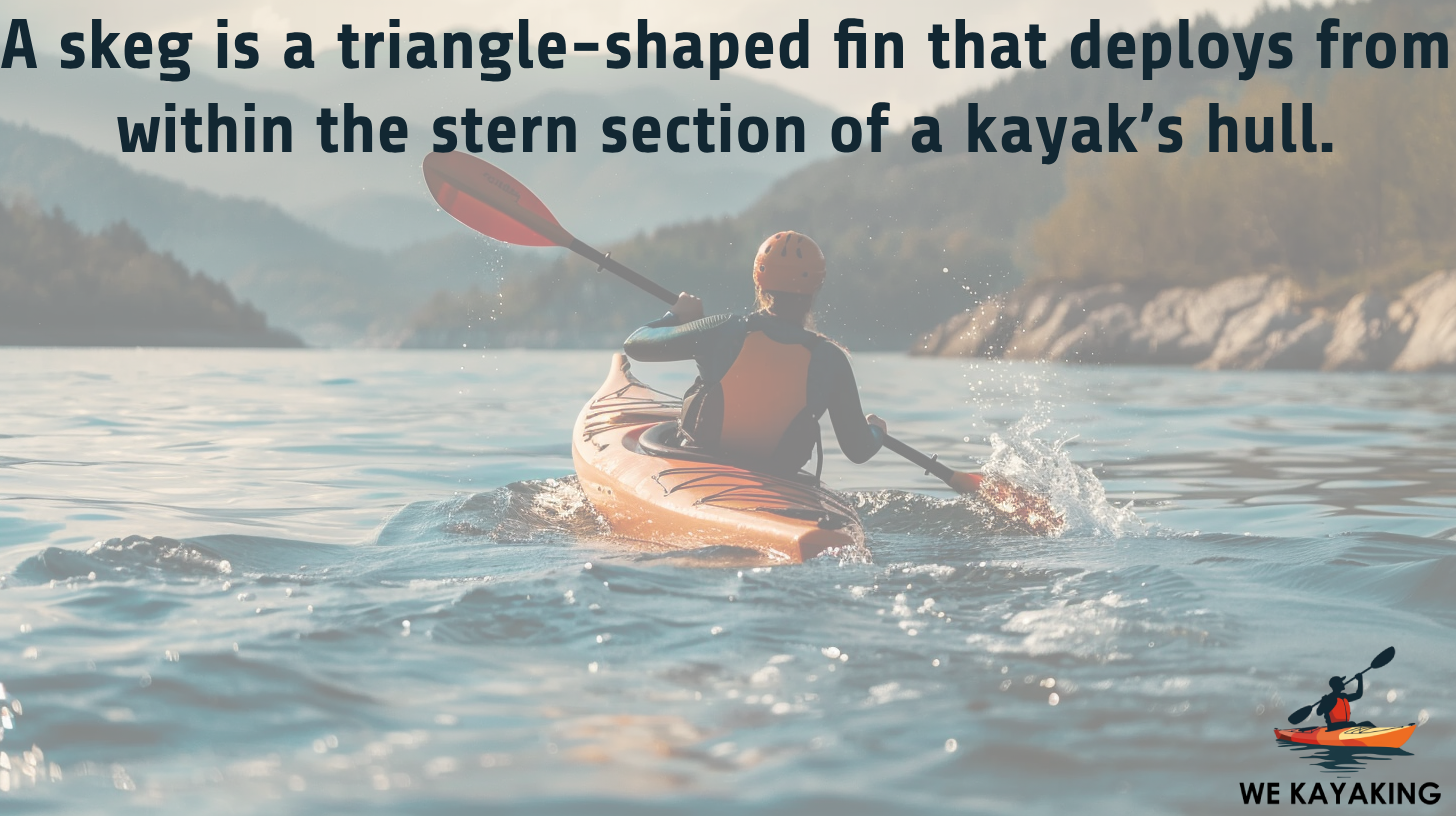 A skeg is a triangle-shaped fin that deploys from within the stern section of a kayak’s hull. Its main function is to aid in tracking, helping the kayak maintain a straight path in the water, particularly in windy conditions or rough waters. Unlike a rudder, which is used to steer a kayak, a skeg is fixed in terms of lateral movement and only extends downward to increase the kayak’s resistance against sideways motion caused by wind or currents.
A skeg is a triangle-shaped fin that deploys from within the stern section of a kayak’s hull. Its main function is to aid in tracking, helping the kayak maintain a straight path in the water, particularly in windy conditions or rough waters. Unlike a rudder, which is used to steer a kayak, a skeg is fixed in terms of lateral movement and only extends downward to increase the kayak’s resistance against sideways motion caused by wind or currents.
The presence or absence of a skeg influences the decision-making process when choosing a kayak. For paddlers who plan to navigate open waters or areas prone to strong winds, a kayak equipped with a skeg could be highly beneficial. It reduces the need for corrective paddling, thereby conserving energy and allowing for a more enjoyable experience. On the other hand, if you’re primarily paddling in calm, sheltered waters, the necessity of a skeg diminishes, and it is not a critical factor in your kayak selection.
What determines kayak comfort?
Kayak comfort is influenced by several key factors that are crucial to consider when choosing a kayak. The design of the kayak seat plays a key role, with features such as ample cushioning, good back support, and adjustability enhancing comfort. The material of the seat also impacts comfort, with high-quality foam or gel-filled options providing better support.
The seating position within the kayak is another important factor. A position that promotes proper posture and allows for easy leg movement greatly enhances comfort. Ergonomics is crucial as well, with ergonomically designed seats providing better support and reducing fatigue during long hours on the water. The overall size and stability of the kayak affect comfort, with wider and more stable kayaks being more comfortable, especially for beginners or those seeking a leisurely experience. The presence of adequate padding and cushioning in the seat is vital to reducing pressure on the backside and makes sitting for extended periods more comfortable.
Moreover, factors such as the kayak’s design, including its size and stability, play a role in how comfortable you feel. When selecting a kayak, it’s essential to consider these factors to ensure a comfortable paddling experience. Testing different kayaks and seats helps you find the best fit for your needs, ensuring that your time on the water is enjoyable and pain-free. For more detailed insights, you read the full discussions at Tricky Fish and Kayak Seeker X.
What affects the maneuverability of the kayak?
The maneuverability of a kayak is affected by several key factors, including its length, width, design, weight, and the paddler’s skills and techniques. Shorter kayaks, especially whitewater models, are known for their exceptional maneuverability, allowing paddlers to make quick turns and navigate through challenging waters with ease, thanks to their specialized designs like rocker profiles and planing hulls. However, these kayaks sacrifice speed and straight-line tracking due to their shorter length.
The width of a kayak also plays a crucial role. Narrower kayaks tend to be faster and more responsive, allowing for better maneuverability, while wider kayaks provide greater initial stability but feel slower and less nimble. This balance between stability and maneuverability is crucial when choosing a kayak, especially for beginners who prioritize stability but will eventually seek more performance-oriented options as they gain experience.
Material and construction also impact maneuverability. Lightweight kayaks are easier to handle and accelerate, but it’s essential to balance weight with durability to ensure the kayak’s longevity. The paddler’s weight and how gear is loaded onto the kayak affect its waterline, influencing both speed and maneuverability.
What is a kayak rudder?
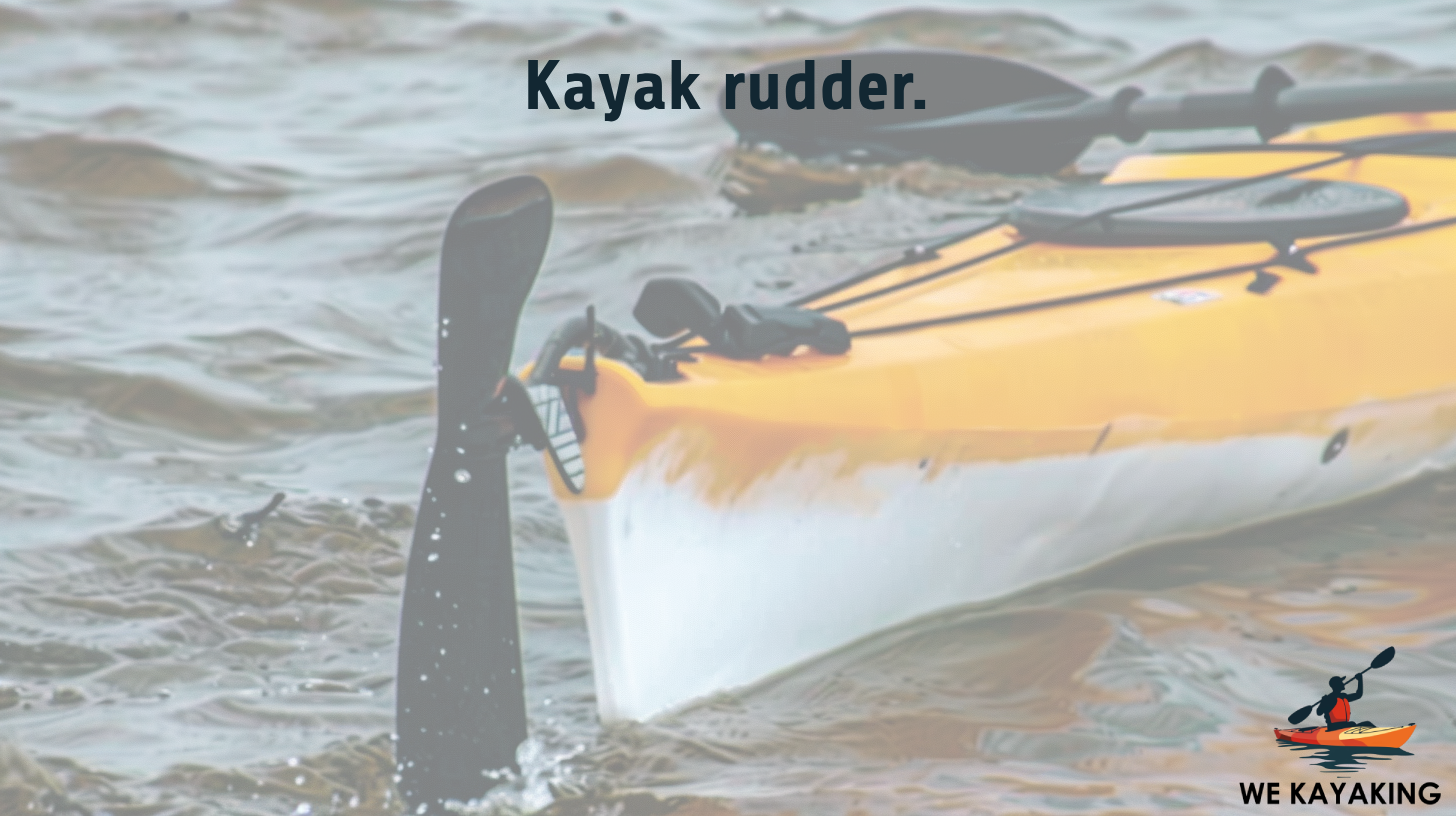 A kayak rudder is a pivotal tool that enhances the maneuverability and directional stability of a kayak, particularly in challenging conditions such as strong currents, winds, or waves. A rudder is a blade attached to the stern of the kayak that pivots from side to side, providing the paddler with the ability to steer the kayak more precisely. This mechanism is especially beneficial when traversing long distances, where maintaining a straight course becomes physically taxing.
A kayak rudder is a pivotal tool that enhances the maneuverability and directional stability of a kayak, particularly in challenging conditions such as strong currents, winds, or waves. A rudder is a blade attached to the stern of the kayak that pivots from side to side, providing the paddler with the ability to steer the kayak more precisely. This mechanism is especially beneficial when traversing long distances, where maintaining a straight course becomes physically taxing.
The rudder system is ingeniously controlled from the comfort of the kayak’s cockpit. Foot pedals, positioned within easy reach of the paddler, are connected to the rudder with stainless steel cables or a very strong cord. By applying pressure to these pedals, the paddler subtly adjusts the rudder’s angle, thus changing the kayak’s direction without needing to alter their paddling stroke. This setup allows for more efficient use of energy, as it reduces the need for corrective strokes that would otherwise be necessary to maintain course or navigate turns.
How much weight can kayaks hold?
The weight capacity of a kayak is a crucial factor to consider because it determines how much weight the kayak safely handles. It includes both the paddler and any additional gear. Kayaks have a range of weight limits depending on their type and design. For instance, recreational kayaks have weight capacities ranging from 200 to 350 pounds (90 to 158 kilograms), while touring kayaks hold between 200 to 450 pounds (90 to 204 kilograms). Fishing kayaks are built to support more weight, with limits ranging from 300 to 550 pounds (136 to 249 kilograms), and tandem kayaks handle between 400 to 650 pounds (181 to 295 kilograms). Inflatable kayaks offer a wide range, with some capable of supporting 350 to 750 pounds (158 to 340 kilograms).
It’s important to note that not all of a kayak’s weight limit is considered usable capacity. The “70% rule” suggests that a kayak performs best when loaded to only 70% of its maximum capacity. For example, a kayak with a 400-pound (181 kilograms) limit should ideally carry no more than 280 pounds (127 kilograms) for optimal performance. This adjustment ensures the kayak remains stable, maneuverable, and efficient in the water.
When selecting a kayak, considering your weight and the total weight of your gear is essential. Kayaks are designed with different volumes and sizes to accommodate various paddler weights and intended uses. For instance, kayaks for kids start at about 100 lb (45 kg) capacity, while tandem kayaks exceed 600 lb (272 kg). Ensuring that the kayak you choose supports your weight plus any additional gear is critical for safety and performance.
Exceeding a kayak’s weight limit impacts its performance. The kayak sits lower in the water, becoming less stable and more difficult to maneuver. In extreme cases, overloading risks capsizing or taking on water. Therefore, it’s crucial to select a kayak with a suitable weight capacity for your needs, keeping in mind the potential weight of any gear you plan to bring along.
What is the difference between a kayak and a canoe?
Kayaks and canoes are both popular choices for paddling enthusiasts, but they have distinct differences that influence your choice depending on your preferences and needs. Here is a brief overview of canoes vs kayaks.
One of the main differences between the two is their structure. Canoes are open on top and are paddled with a single-bladed paddle. They are known for their cargo capacity, making them ideal for carrying more gear or passengers. Kayaks, on the other hand, have a closed deck with a cockpit where the paddler sits inside, using a double-bladed paddle for propulsion. This design offers better protection against water and is preferred for solo paddling.
When it comes to stability, canoes offer more initial stability due to their wider build, making them feel more secure in calm waters. Kayaks, particularly those with rounded or V-shaped hulls, provide better secondary stability, making them more suited to rough waters and skilled paddlers who handle the kayak’s tendency to tilt without capsizing.
In terms of speed and maneuverability, kayaks outperform canoes. Their sleeker design allows for faster movement through the water and easier maneuvering. Canoes, being larger and heavier, require more effort to paddle and achieve the same speeds as kayaks.
For beginners, the choice between a kayak and a canoe comes down to the intended use and comfort of the paddling technique. Kayaks are considered easier for first-timers due to their straightforward paddling method and lower center of gravity, which helps in maintaining balance. Canoes, with their larger capacity and open design, are more appealing for those looking to paddle in groups or carry more gear.
What equipment is required to use a kayak?
The equipment needed to fully enjoy and safely participate in kayaking, especially if you’re planning to navigate rivers, there’s a specific set of equipment that is considered essential. This includes a life jacket designed for paddling, which offers a greater range of motion and features to ensure safety without impeding your ability to paddle efficiently. A neoprene spray skirt for sit-inside kayaks to prevent water from entering the cockpit, keeping you dry and ensuring the kayak remains buoyant. A protective helmet is a must-have for whitewater or rocky conditions to protect your head from impacts.
A durable paddle that matches your size, kayak type, and paddling style is importnat. It’s your primary tool for maneuvering and propelling the kayak, so its quality and fit are crucial. Additionally, sticky river shoes provide essential grip on slippery surfaces, both in and out of the water, enhancing safety during launches, landings, and portages.
For anyone kayaking rivers, particularly in whitewater conditions, carrying a throw bag of rope is recommended for rescues, either for self-rescue or to assist others. A whistle and a rescue knife are also basic whitewater kayak safety gear, with the whistle serving as a signaling device in case of emergency, and the knife being useful for cutting entangled ropes or in other rescue scenarios.
What type of paddle is used for kayaking?
For kayaking, the type of paddle used is a double-bladed paddle, which allows kayakers to alternate strokes on either side of the kayak for efficient propulsion. The paddles are made from various materials like carbon, fiberglass, and aluminum, with each offering different benefits in terms of weight and temperature sensitivity.
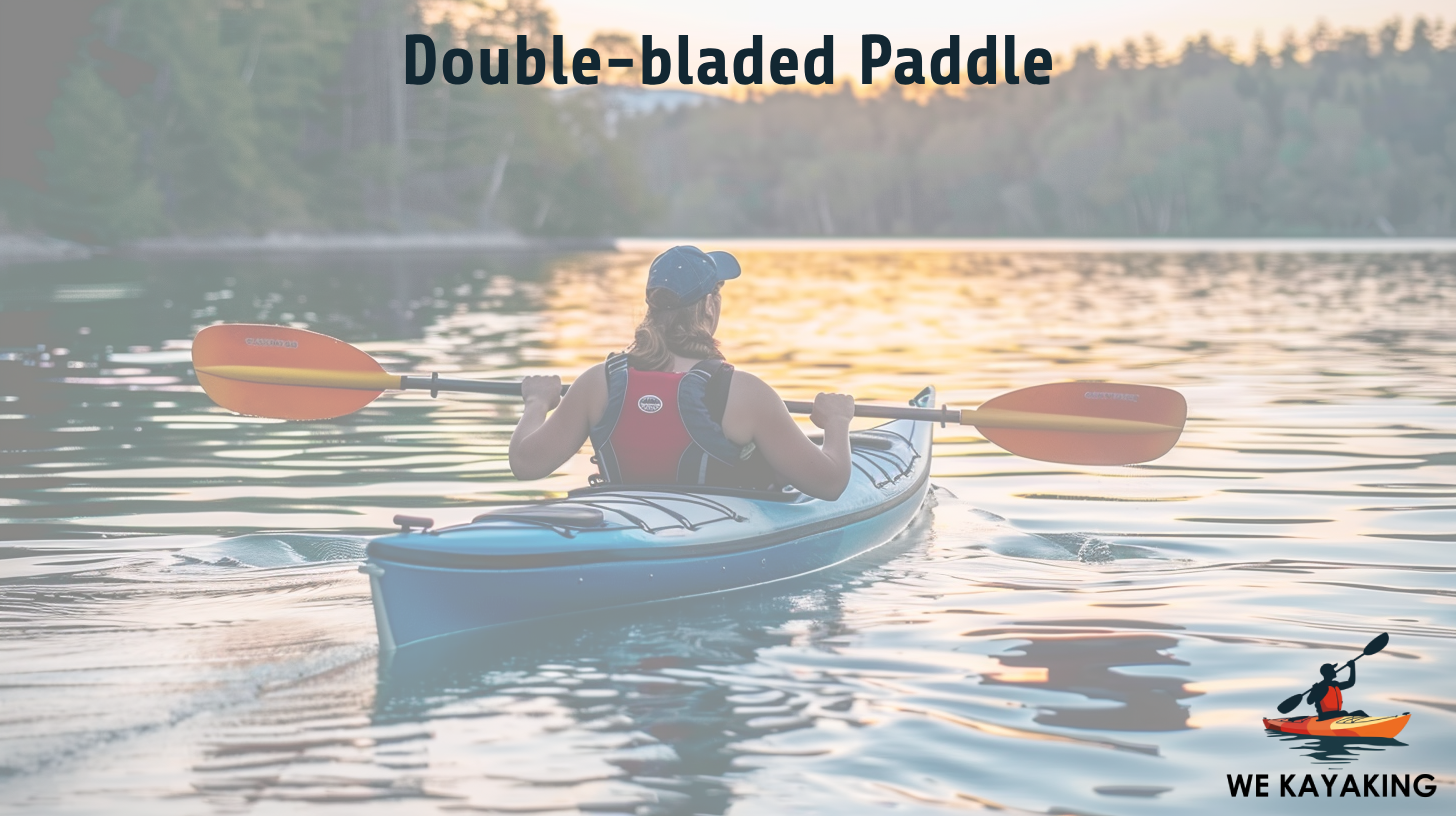 Paddles also come in different shaft designs, including straight and bent shafts, with bent shafts designed to reduce wrist fatigue by allowing a more natural grip. Some paddles are feathered, setting the blades at a 90-degree angle to each other to reduce wind resistance and improve efficiency.
Paddles also come in different shaft designs, including straight and bent shafts, with bent shafts designed to reduce wrist fatigue by allowing a more natural grip. Some paddles are feathered, setting the blades at a 90-degree angle to each other to reduce wind resistance and improve efficiency.
Is it hard to learn to paddle a kayak?
No, learning to paddle a kayak is not considered hard for most people. It is a relatively straightforward skill to pick up with some basic instruction and practice. Beginners are able to quickly learn the fundamentals of kayaking, such as how to hold the paddle correctly, perform forward and backward strokes, and steer the kayak. However, mastering more advanced techniques and handling challenging water conditions takes more time and experience. Starting with calm waters and progressing gradually is a good approach for new paddlers.
What are the age requirements for using a kayak?
The age requirement for using a kayak starts as young as 8 to 10 years old, under close adult supervision and in appropriate water conditions. However, this varies depending on local regulations, the specific kayaking activity, and the child’s physical ability, maturity, and experience.
Kayaking offers a fantastic opportunity for individuals of all ages to explore waterways, get close to nature, and engage in physical activity. When it comes to younger enthusiasts, the key is to ensure they are paddling in a safe environment suited to their skill level. Youth kayaks are smaller, lighter, and designed to be more stable to accommodate the needs of younger paddlers. Guardians or instructors need to assess a child’s readiness for kayaking, which includes swimming ability, understanding of safety instructions, and comfort level with being on the water. Structured lessons or guided tours are an excellent way for young or inexperienced kayakers to learn and enjoy the sport safely.
What environment is suitable for kayaking?
Suitable environments for kayaking encompass a broad range of water bodies, from serene lakes and gentle rivers to more adventurous sea kayaking along coastlines and challenging whitewater rapids. The key to a fulfilling kayaking experience lies in matching the environment to the kayaker’s skill level, preferences, and the type of kayak being used.
For beginners, calm, flat waters such as lakes, slow-moving rivers, and protected coastal areas offer an ideal setting to learn basic paddling techniques and build confidence. These environments provide a safe and controlled setting for new paddlers to get accustomed to handling a kayak, mastering balance, and understanding how to navigate through the water.
Intermediate kayakers seek the thrill of slightly more dynamic waters, including faster-flowing rivers and estuaries, where they hone their skills in maneuvering and dealing with currents and slight waves. Sea kayaking along coastlines presents a unique blend of exploration and challenge, with the opportunity to navigate through different sea conditions, tides, and wind effects, requiring a good understanding of maritime navigation and weather patterns.
For the most experienced adventurers, whitewater kayaking in rivers with rapids ranging from Class I (easy) to Class V (extremely difficult) offers an adrenaline-fueled experience. This environment demands a high level of skill, swift decision-making, and an intimate understanding of water dynamics, making it suitable only for well-trained enthusiasts.
Can you go kayaking in a lake?
Yes, you can go kayaking in a lake. A lake is a sizable body of standing freshwater surrounded by land, found in basins or areas where water collects. Lakes offer a tranquil and controlled environment for kayaking. From beginners to seasoned enthusiasts, lakes are a chill place for every paddler to unwind, connect with nature, and enjoy the serene beauty of tranquil waters at their own pace.
When kayaking in a lake, using a recreational or touring kayak is suitable due to their stability, ease of use, and comfort over longer distances. Recreational kayaks are wider, offering more stability, which is ideal for calm waters like those found in lakes. Touring kayaks, on the other hand, are longer and designed for distance paddling, providing efficiency and storage capacity for longer adventures.
It’s important to consider safety gear, such as life vests, and to check weather conditions before heading out, as lakes sometimes are prone to sudden wind changes. Additionally, understanding basic navigation and being mindful of other water users enhance the kayaking experience on a lake.
Can you go kayaking in the ocean?
Yes, you can go kayaking in the ocean. The ocean is a vast body of saltwater that covers approximately 71% of the Earth’s surface. It is characterized by its variable conditions, including waves, currents, and tides. Ocean kayaking offers an adventurous experience, allowing paddlers to explore coastal areas, open waters, and marine environments.
When kayaking in the ocean, it’s important to use a sea/touring kayak or an ocean kayak, which are designed specifically for the challenges of ocean paddling. These kayaks are longer and narrower than recreational kayaks, providing better stability in choppy water, efficiency over long distances, and features like watertight compartments for gear storage. They also come equipped with a rudder or skeg to help with steering in strong currents and winds.
Safety considerations are paramount when ocean kayaking. It’s crucial to have a solid understanding of maritime navigation, be aware of weather and sea conditions, and have the ability to perform self-rescue. Wearing appropriate safety gear, including a life vest and possibly a helmet in rocky areas, and having communication devices in case of emergencies are also important. For those new to ocean kayaking, starting with guided tours or in the company of experienced kayakers provides a safer and more enjoyable introduction to this exhilarating form of paddling.
Can you go kayaking in the river?
Yes, you can go kayaking in a river. A river is a naturally flowing watercourse, usually freshwater, flowing towards an ocean, sea, lake, or another river. Rivers vary greatly in their flow, depth, and the nature of their banks. They offer diverse kayaking experiences, from calm, scenic paddles to exhilarating whitewater adventures.
The type of kayak best suited for river kayaking depends largely on the river’s conditions. For gentle rivers with slow-moving water, a recreational kayak is a good choice due to its stability and ease of use. These kayaks are ideal for leisurely paddles and wildlife observation. For rivers with rapids and more challenging conditions, a whitewater kayak is necessary. These kayaks are shorter and more maneuverable, designed to handle fast-flowing water and navigate through rocks and other obstacles.
When kayaking in rivers, safety comes first. It’s important to be aware of the river’s current, potential hazards, and any changes in weather conditions. Wearing a life vest, helmet, and other appropriate safety gear is essential, especially in rougher waters. A secure and pleasurable river kayaking experience also depends on having a solid grasp of river navigation and paddling techniques.
Can you go kayaking in the sea?
Yes, you can go kayaking in the sea. The sea is a large body of saltwater that is connected to an ocean and is partially or fully enclosed by land. Sea kayaking allows paddlers to explore coastal areas, visit secluded beaches, and enjoy marine wildlife, offering both serene and challenging experiences depending on the sea conditions and weather.
For sea kayaking, using a sea kayak or touring kayak is essential. These kayaks are designed for stability and efficiency over longer distances in open water. They feature a longer and narrower shape to cut through waves and currents more effectively and have a watertight storage compartment for gear and supplies.
When kayaking in the sea, it’s crucial to be prepared for varying conditions. This includes having a good understanding of sea navigation, being aware of tides and currents, and knowing how to deal with potential weather changes. Safety equipment such as life vests, spray skirts (to keep water out of the kayak), and possibly a helmet in rocky coastal areas, is also important. Given the potential for more challenging conditions, gaining experience with guided tours or groups and having a solid foundation in kayaking skills and safety practices is highly recommended for sea kayaking.
Can you go kayaking in a canal?
Yes, you can go kayaking in a canal. A canal is a man-made waterway constructed to allow for the passage of boats or to convey water for irrigation. Canals range from narrow, serene waterways in urban or rural settings to larger channels connecting different bodies of water. Kayaking in a canal offers a unique way to explore cityscapes, countryside, and historical sites from the water.
For canal kayaking, a recreational kayak is a great choice due to its stability, comfort, and ease of handling. These kayaks are well-suited for the calm waters found in canals. They are also ideal for leisurely paddles, sightseeing, and photography.
When kayaking in canals, it’s important to be mindful of boat traffic, particularly in busier or narrower canals, and to be aware of any local regulations regarding right-of-way and access. Safety gear such as life vests should always be worn, and paddlers should be prepared for varying weather conditions. Since canals are sheltered from wind and waves, they provide a peaceful kayaking experience, making them an excellent choice for beginners or those looking for a relaxed paddle.
What weather is recommended for kayaking?
When planning a kayaking excursion, the subtleties of the weather greatly influence the quality and safety of your experience. Opting for a day with light winds is crucial, as strong gusts lead to choppy water conditions, making navigation and control more challenging. Gentle breezes, on the other hand, provide a smoother ride and even aid in cooling you down under the sun.
The importance of moderate temperatures isn’t overstated. Conditions that are too hot lead to dehydration and sunburn, particularly on open water where shade is scarce. Conversely, cold conditions not only make for an uncomfortable outing but also pose risks such as hypothermia if you get wet. Therefore, a temperature range that ensures comfort without the need for excessive gear to either warm up or cool down is ideal. Specifically, aiming for temperatures between 60°F to 75°F (15°C to 24°C) provides a comfortable balance for most paddlers.
Clear skies contribute to not only the enjoyment of scenic views but also to safety on the water. Good visibility allows you to spot potential hazards, navigate more effectively, and communicate with fellow kayakers. While kayaking under a light drizzle sometimes adds to the adventure, especially in warmer climates, being caught in a downpour quickly becomes less than ideal, affecting visibility and altering water levels and flow rates.
The ability to predict the weather is crucial for organizing a successful kayaking excursion. Sudden storms or wind shifts transform a serene paddle into a challenging ordeal. Checking the weather forecast in advance and keeping an eye on the sky help you avoid being caught in unfavorable conditions. Equipping yourself with the right gear for the forecasted conditions is also essential. Along with the kayak and paddle, this also includes any personal gear like thermal layers, waterproof clothes, sun protection, or a life jacket. Understanding and respecting the weather’s influence on kayaking conditions will not only enhance your enjoyment but also ensure that your adventure remains safe and memorable.
Is it safe to kayak during winter?
Yes, Kayaking during winter months is indeed feasible and is safely enjoyed with the right precautions and preparations in place. The serene and deserted waterways provide a unique kayaking experience, highlighted by crisp air and the tranquil beauty of winter landscapes. That being said, the colder temperatures and potential presence of ice necessitate a higher level of preparation and caution. Organizations such as the American Canoe Association (ACA) and the National Center for Cold Water Safety emphasize the importance of proper gear, knowledge, and preparation when engaging in any cold-water activities.
Firstly, wearing appropriate gear is paramount for winter kayaking. This includes donning a dry suit or wet suit designed to protect against the cold waters, effectively reducing the risk of hypothermia. These suits, combined with thermal underlayers, create an essential barrier against the cold, ensuring the paddler remains warm and dry.
Moreover, an in-depth understanding of cold water safety is critical. Knowledge of hypothermia symptoms, along with swift and effective response strategies in case of immersion, is life-saving. It’s also vital to ensure that the kayak and all equipment are in good condition to handle the rigors of winter paddling. Checks should be thorough, with special attention to the integrity and functionality of safety gear.
Lastly, the unpredictable nature of winter weather requires paddlers to stay informed about the latest weather conditions and be prepared to adjust plans accordingly. The beauty and peace of winter kayaking come with the responsibility of meticulous preparation and a respectful acknowledgment of the season’s challenges.
Do you need a license to kayak?
The necessity for a license to kayak varies depending on the location and the specific laws that govern watercraft in that region. In many places around the world, kayaks, particularly those that are non-motorized, do not require the operator to have a license. This is due to their classification as non-powered vessels, which subjects them to fewer regulations. However, certain areas do mandate the registration of the kayak or adherence to specific local rules, such as safety equipment requirements or usage permits for specific water bodies.
For example, in the United States, the need for registration or permits differs significantly from one state to another. States like Ohio require registration for all non-powered watercraft over a certain length, whereas in California, such vessels are exempt from registration.
In contrast, in the United Kingdom, navigating many inland waterways in England and Wales necessitates a license from relevant authorities. Unlike in Scotland, where broader access rights are granted to kayakers.
Similarly, in Australia, non-powered vessels like kayaks do not need to be registered, but users must comply with safety regulations. Meanwhile, in Canada, while non-motorized kayaks usually don’t require registration, specific provinces impose safety equipment standards and operator competency requirements, such as holding a Pleasure Craft Operator Card if the kayak has a motor.
Can you go on a kayak with two people aboard?
Yes, you can go on a kayak with two people aboard, provided you are using a tandem kayak designed specifically for this purpose. Tandem kayaks, often referred to as double kayaks, are built longer and have two seating positions to accommodate two paddlers. This design not only allows for companionship during the journey but also makes paddling more efficient, as the combined strength and coordination of two paddlers propel the kayak more effectively than a single paddler in some instances.
To preserve stability and safety, it is crucial to take into account the kayak’s weight capacity and make sure it is not exceeded. Coordination and communication between the two paddlers are also crucial in a tandem kayak to synchronize paddling efforts and navigate effectively. Tandem kayaking is an excellent way to enjoy the water, whether you are looking to go on more daring excursions in exciting environments or just take a leisurely stroll on serene waters. It is also a great chance for less seasoned kayakers to pick up tips from more accomplished paddlers.
What are the activities that kayaks are used for?
Kayaking is a versatile and engaging sport that offers a wide range of activities suitable for water enthusiasts of all skill levels. From the thrill of navigating whitewater rapids to the serene pleasure of a quiet lake fishing trip, kayaking provides unique ways to connect with the water. Here’s a list of popular kayaking activities;
- Surf Kayaking
- Fishing
- Sea Kayaking
- Camping
- Sailing
- Ecotourism
- Flatwater Recreation
- Racing
- Whitewater
- Surf Kayaking
Surf kayaking blends elements of surfing and kayaking, where paddlers use specially designed kayaks to ride ocean waves. These kayaks are built to be robust and maneuverable, allowing paddlers to navigate the surf and perform turns. The sport requires a good understanding of wave patterns and surf etiquette, providing an exhilarating experience that combines the rush of surfing with the control of paddling.
- Fishing
Kayak fishing has gained popularity due to the accessibility and low cost of kayaks compared to traditional fishing boats. Kayaks allow anglers to access remote or shallow waters that are off-limits to larger vessels. Fishing kayaks are equipped with rod holders, gear storage, and even fish finders, making them an efficient and quiet way to approach fish without startling them.
- Sea Kayaking
Sea kayaking involves paddling along coastal waters, exploring sea caves, and navigating around islands and archipelagos. Sea kayaks are designed for stability and efficiency over long distances, equipped with storage compartments for multi-day trips. This activity is cherished for its ability to get close to marine environments and wildlife, offering a unique perspective on the world’s coastlines.
- Camping
Kayak camping combines kayaking with wilderness camping, allowing paddlers to reach secluded camping spots along rivers, lakes, and coastal areas. Kayaks carry camping gear in their watertight compartments, enabling multi-day adventures in nature. This activity is perfect for those who wish to combine the joys of kayaking with the love of outdoor camping.
- Sailing
Kayak sailing introduces a sail to the kayak, harnessing wind power to glide across the water. This activity adds a new dimension to kayaking, requiring skills in both paddling and sail handling. Kayak sails are added to many types of kayaks, offering a faster and less labor-intensive way to cover greater distances.
- Ecotourism
Ecotourism kayaking focuses on sustainable travel that conserves the environment and improves the well-being of local people. Kayaking offers a low-impact way to explore sensitive ecosystems, such as mangroves, coral reefs, and wetlands, without causing pollution or disturbance. This activity emphasizes the appreciation and conservation of natural areas.
- Flatwater Recreation
Flatwater kayaking is enjoyed on calm bodies of water such as lakes, slow-moving rivers, and ponds. It’s ideal for beginners and those seeking a relaxing experience on the water. This type of kayaking is perfect for leisurely paddles, photography, bird watching, and simply enjoying the tranquility of still waters.
- Racing
Kayak racing is a competitive activity that challenges paddlers’ speed and endurance. Races occur on various types of water, from calm lakes to flowing rivers, and range in distance from short sprints to long-distance marathons. Racing kayaks are slim and lightweight, designed for maximum speed and efficiency.
- Whitewater
Whitewater kayaking involves navigating through river rapids of varying difficulty levels. It’s an adrenaline-fueled sport that requires technical skills, quick decision-making, and an understanding of river dynamics. Whitewater kayaks are short and maneuverable, allowing paddlers to perform precise movements and safely navigate through turbulent waters.
What are the most popular brands of kayaks?
The world of kayaking offers a variety of kayak brands known for their quality, innovation, and specialization in different types of kayaking activities. Here are ten of the most popular brands:
- Wilderness Systems
- Perception Kayaks
- Hobie
- Old Town Canoes & Kayaks
- Dagger
- Jackson Kayak
- Ocean Kayak
- Advanced Elements
- Intex
- Sea Eagle
- Wilderness Systems
Renowned for their innovative designs and high-quality construction, Wilderness Systems kayaks are favored by both recreational paddlers and expedition kayakers. They offer a wide range of kayaks, including touring, recreational, and fishing models, known for their comfort, stability, and performance.
- Perception Kayaks
Perception has built a reputation for creating durable and user-friendly kayaks, making them a great choice for beginners and experienced paddlers alike. Their lineup includes everything from recreational and touring kayaks to specialized fishing kayaks, all designed with safety and reliability in mind.
- Hobie
Hobie is famous for their pedal kayaks, which use a unique MirageDrive system allowing for hands-free propulsion. This innovation has made Hobie kayaks particularly popular among anglers and those who appreciate the ability to navigate without a paddle.
- Old Town Canoes & Kayaks
With a heritage that dates back over a century, Old Town is known for combining traditional craftsmanship with modern materials. They offer a wide selection of recreational, fishing, and touring kayaks, distinguished by their durability and comfort.
- Dagger
Dagger caters to the adventurous spirit with their line of whitewater and touring kayaks. Known for their maneuverability and robust construction, Dagger kayaks are designed to tackle everything from calm rivers to challenging rapids.
- Jackson Kayak
Founded by world champion kayaker Eric Jackson, this brand is deeply rooted in the whitewater community but has expanded to include fishing and recreational kayaks. Jackson Kayak is known for innovative designs and a strong commitment to quality.
- Ocean Kayak
As the name suggests, Ocean Kayak specializes in sit-on-top kayaks designed for ocean paddling. Their kayaks are known for being stable, easy to enter and exit, and suitable for paddlers of all skill levels, making them a popular choice for recreational and fishing activities.
- Advanced Elements
Advanced Elements stands out for their inflatable kayaks, which combine portability and ease of storage with the performance of traditional hard-shell kayaks. Their products are ideal for those with limited storage space or those who like to travel with their kayak.
- Intex
Intex is known for their affordable inflatable kayaks and boats. While not as performance-oriented as some other brands, Intex kayaks offer a cost-effective way for beginners to get started with kayaking.
- Sea Eagle
Specializing in inflatable vessels, Sea Eagle offers a range of kayaks designed for all types of water, including whitewater, ocean, and flatwater paddling. Their kayaks are appreciated for their durability, stability, and ease of transport.
How to choose a kayak?
Choosing the right kayak involves considering several key criteria to ensure it meets your needs, preferences, and budget. These criteria include price, type, size, speed, weight, materials, shapes, stability, comfort, maneuverability, and weight limit.
When it comes to price, setting a budget is crucial as kayaks range from affordable entry-level models to high-end specialized kayaks. Investing more offers better materials, features, and longevity, but there are great options available at various price points.
The type of kayak is important to consider based on where and how you plan to use it. For instance, recreational kayaks are ideal for calm waters and short outings, while touring kayaks are better suited for longer distances in open waters. Fishing kayaks come equipped with features like rod holders and storage space, whereas whitewater kayaks are designed for maneuverability in rapids.
Size and speed are closely related; longer kayaks tend to be faster and track better, making them suitable for open water and longer distances. Shorter kayaks are more maneuverable, ideal for rivers and tight spaces.
Weight and materials influence the kayak’s portability and durability. Lighter kayaks are easier to transport, with inflatable and plastic models being among the lightest. Materials like polyethylene offer durability and impact resistance, while composite materials such as fiberglass or carbon fiber provide lighter weight and higher performance but at a higher cost.
The shape and stability of the kayak are key for beginners and those using kayaks for fishing or photography, who prefer a wider hull for more primary stability. Advanced paddlers opt for a narrower shape for speed and secondary stability in rougher conditions.
Comfort is crucial, especially for longer trips, so look for kayaks with adjustable footrests, ergonomic seats, and sufficient legroom. Maneuverability is important for navigating through tight spots and making quick turns, with shorter and more rounded hulls offering greater maneuverability. Considering the weight limit of the kayak is also crucial when choosing your kayak since it affects the stability, performance, and safety of your paddling experience.
How much does a regular kayak cost?
The cost of a regular kayak varies widely, ranging from about $250 to over $1,500. Entry-level recreational kayaks start around $250 to $500, offering basic features suitable for calm waters and short trips. Mid-range kayaks, which could include more specialized touring, fishing, or whitewater models with enhanced features for comfort and performance, range from $600 to $1,000. High-end kayaks, made from premium materials with advanced designs for specific activities, exceed $1,500.
The price of a kayak influences the process of choosing one, as it reflects factors like the kayak’s material, design, durability, and specialized features. A higher price tag denotes better quality materials such as lightweight and durable composite constructions, advanced design features for specific types of kayaking, and added comforts such as adjustable seating and ample storage. On the other hand, more affordable kayaks are made from heavier materials and have fewer features, but they are still a great choice for beginners or casual paddlers.
When selecting a kayak, it’s important to consider how the cost aligns with your kayaking goals, frequency of use, and desired features. Investing in a more expensive kayak makes sense for avid kayakers looking for performance and durability, while those new to the sport or partaking in casual outings find better value in a lower-cost model. Ultimately, balancing cost with your specific needs and preferences is key to finding the right kayak.
What determines the price of a kayak?
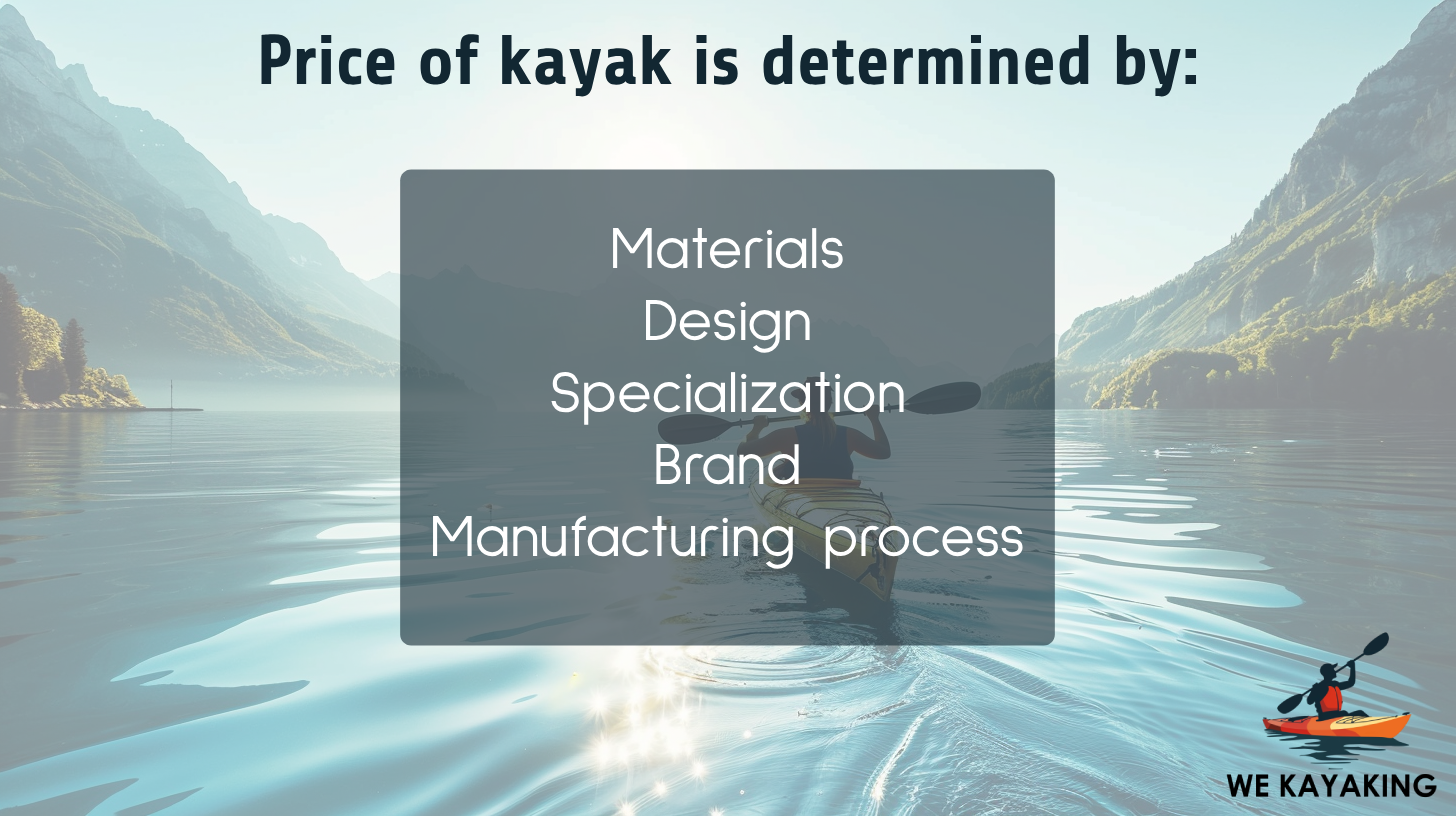 The price of a kayak is influenced by a variety of factors that contribute to its overall quality, performance, and features. One of the primary determinants is the materials and construction used in the kayak. High-end kayaks utilize advanced composite materials such as fiberglass, Kevlar, or carbon fiber, which are lightweight and offer superior performance and durability but come at a higher cost. In contrast, more affordable kayaks are made from heavier, but less expensive, materials like polyethylene or inflatable PVC, which are durable but do not offer the same performance level.
The price of a kayak is influenced by a variety of factors that contribute to its overall quality, performance, and features. One of the primary determinants is the materials and construction used in the kayak. High-end kayaks utilize advanced composite materials such as fiberglass, Kevlar, or carbon fiber, which are lightweight and offer superior performance and durability but come at a higher cost. In contrast, more affordable kayaks are made from heavier, but less expensive, materials like polyethylene or inflatable PVC, which are durable but do not offer the same performance level.
Another crucial factor is the design and specialization of the kayak. Kayaks designed for specific activities like sea kayaking, whitewater, or fishing have specialized features tailored to those activities, such as reinforced hulls, fishing rod holders, or storage compartments for gear. These specialized designs and added features increase the cost.
Additionally, the brand and manufacturing process play a role in pricing. Well-established brands with a reputation for quality and innovation price their kayaks higher due to their brand value and the research and development that goes into their products. The manufacturing process, including labor costs and the location of production, also affects the final price.
Understanding these factors is crucial when choosing a kayak, as they directly impact what you get for your money. A higher-priced kayak offers better performance, comfort, and longevity, which could be a worthwhile investment for avid kayakers or those looking for specific features. Conversely, for casual or beginner kayakers, a lower-priced model provides the necessary functionality without the additional cost of high-end features. Balancing these factors against your budget, needs, and kayaking aspirations will guide you in selecting a kayak that offers the best value for your investment.
Are expensive kayaks faster?
Yes, expensive kayaks are faster, but this is not solely due to their price but rather the design, materials, and features that come with higher-priced models. Expensive kayaks incorporate advanced design features and lightweight, high-quality materials that contribute to better performance and speed. For instance, they are constructed from composites like fiberglass or carbon fiber, which are not only lighter than the polyethylene used in many budget-friendly models but also allow for more sophisticated hull designs. These materials are shaped into sleeker, more hydrodynamic forms that reduce water resistance and enhance speed.
Moreover, expensive kayaks have longer and narrower hulls, a design choice that improves speed and tracking in the water. They also include performance-enhancing features such as rudders or skegs, which help with straight-line tracking and contribute to a faster, more efficient paddling experience.
When choosing a kayak, considering the importance of speed in relation to other factors like stability, maneuverability, and specific use cases is important. While a faster kayak is desirable for touring or racing, it is not necessary for leisurely paddles, fishing, or whitewater activities where other characteristics are more critical. Ultimately, the decision should be based on a balance between the desired speed, the kayak’s intended use, and other personal preferences.
Are expensive kayaks safer?
No, expensive kayaks are not inherently safer than less expensive ones. Safety in kayaking is more closely related to the kayak’s design, how well it matches the paddler’s skill level, and its suitability for the intended use and conditions, rather than its price.
Expensive kayaks come with advanced features, superior materials, and designs tailored for specific types of kayaking, such as sea, whitewater, or racing. These features include improved ergonomics, enhanced stability in specific conditions, and built-in safety elements like bulkheads in sea kayaks, which provide flotation in the event of a capsize. While these aspects contribute to a safer experience for certain activities, they do not automatically make a kayak safer across the board.
When choosing a kayak, it’s crucial to consider the kayak’s intended use, the environment you’ll be paddling in, and your skill level. A high-priced sea kayak, for instance, is not the safest choice for a beginner paddler due to its narrower design for speed and efficiency, which compromises stability for inexperienced users. Conversely, a moderately priced recreational kayak with a wider hull offers more stability and is safer for casual paddling on calm waters.
Ultimately, safety in kayaking also depends heavily on the paddler’s practices, such as wearing a life jacket, understanding and adhering to safety protocols, and choosing paddling locations appropriate to their skill level. Selecting a kayak that aligns with your experience, intended use, and conditions, while also considering essential safety features, is more critical than focusing solely on the price.
Are expensive kayaks more durable?
Yes, expensive kayaks tend to be more durable due to the higher quality materials and advanced construction techniques used in their manufacturing. Higher-priced kayaks utilize materials like fiberglass, Kevlar, or carbon fiber, which are not only lightweight but also offer superior strength and resistance to impact and wear over time. These materials withstand the rigors of frequent use and challenging conditions, from rocky riverbeds to saltwater exposure, better than cheaper alternatives like basic polyethylene.
Moreover, the construction methods in more expensive kayaks, such as the use of UV-resistant coatings and more sophisticated hull designs, contribute to their longevity and performance. These kayaks are built with long-term use in mind, featuring designs that balance efficiency, speed, and stability without compromising durability.
When choosing a kayak, considering the durability factor is essential, especially if you plan to use it frequently or in demanding conditions. An investment in a more expensive kayak is more cost-effective in the long run, as it requires fewer repairs and has a longer lifespan, providing better value over time. However, it’s important to balance this with your budget and kayaking needs. For casual or occasional use, a less expensive, well-made kayak still offers the durability you need without the higher cost.
How to not overpay for a kayak?
To ensure you don’t overpay for a kayak, it’s crucial to start with a clear understanding of your kayaking needs and preferences. Begin by assessing the type of kayaking you plan to engage in, whether it’s leisurely paddles on calm lakes, fishing, touring, or navigating whitewater. This will help you narrow down the specific features and kayak type that best suits your activities, ensuring you don’t pay extra for specialized features you won’t use. Setting a realistic budget that includes not only the kayak but also essential gear like paddles, life jackets, and transportation racks is another critical step. A well-defined budget acts as a guardrail, helping you filter options and focus on what’s necessary.
Research is key to finding a good deal on a kayak. By comparing different models and brands, reading reviews, and participating in kayaking forums, you gain insights into the best kayaks for your budget and needs. This comparative shopping highlights the best value options and prevents you from paying a premium for brand names without corresponding quality or features. Seasonal sales, clearance events, and second-hand markets also offer opportunities to find high-quality kayaks at reduced prices. When considering a used kayak, thorough inspection for any damage and understanding its history are essential to ensure it’s a wise investment.
Lastly, while it’s important to find a kayak that fits your budget, compromising on essential features for the sake of price is counterproductive. Safety features, durability, and suitability for your intended use should never be compromised. Patience and thorough research lead to finding the right kayak at the right price, ensuring you enjoy your time on the water without overpaying.
Are cheap kayaks good?
Yes, cheap kayaks are good, depending on your specific needs and how you plan to use them. When choosing a kayak, it’s essential to consider how the kayak’s features and capabilities align with your intended activities, experience level, and the conditions in which you’ll be paddling.
Cheap kayaks, made from more affordable materials like polyethylene, offer great value for recreational paddlers, beginners, or those looking for a budget-friendly entry into the sport. These kayaks are stable, durable, and easy to use, making them suitable for calm waters, such as lakes and slow-moving rivers. They are an excellent choice for leisurely paddles, short day trips, or occasional use.
However, it’s important to be aware of the limitations that come with lower-priced kayaks. They lack the performance, comfort, and features of higher-priced models, such as adjustable seats, ample storage, and efficient hull designs for speed and tracking. Cheap kayaks are also heavier and less durable than more expensive options made from advanced materials.
Experience has taught me that when considering a cheap kayak, it’s crucial to assess the kayak’s build quality and confirm that it has the necessary features for your planned activities. Reading reviews and possibly testing the kayak before purchase help determine if a lower-cost option will meet your expectations and provide a satisfactory kayaking experience.
What is a good price for a kayak?
A good price for a kayak ranges from $250 to over $1,500, depending on the type, quality, and features of the kayak. Entry-level recreational kayaks start around $250 to $500, offering basic functionality for calm water paddling. Mid-range models, which include more specialized kayaks for touring, fishing, or whitewater, cost between $600 and $1,000. These kayaks come with enhanced features for comfort, performance, and convenience. High-end kayaks, made with advanced materials for professional or specialized use, exceed $1,500.
The price point you consider “good” depends on your specific kayaking needs and how you balance cost with the value offered by the kayak. From what I know, an entry-level recreational kayak is perfectly adequate and priced right for someone new to the sport or someone who plans to kayak occasionally on calm waters. For more experienced kayakers or those requiring specific features for activities like long-distance touring, fishing, or navigating challenging whitewater, investing in a mid-range or high-end model offers better value in terms of durability, performance, and safety.
When choosing a kayak, consider how the price reflects the kayak’s construction quality, material, design, and additional features such as storage options, seating comfort, and overall performance. A higher price indicates a kayak built with lighter, more durable materials, such as fiberglass or carbon fiber, and with design considerations for specific types of kayaking. However, it’s important to assess whether these features are necessary for your kayaking activities and worth the additional cost.
